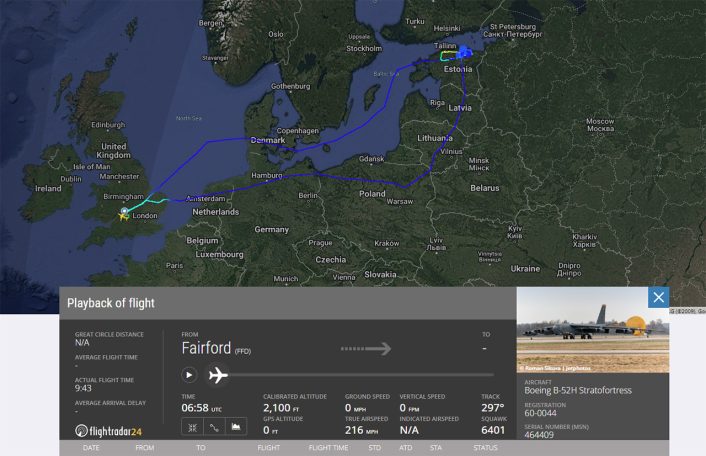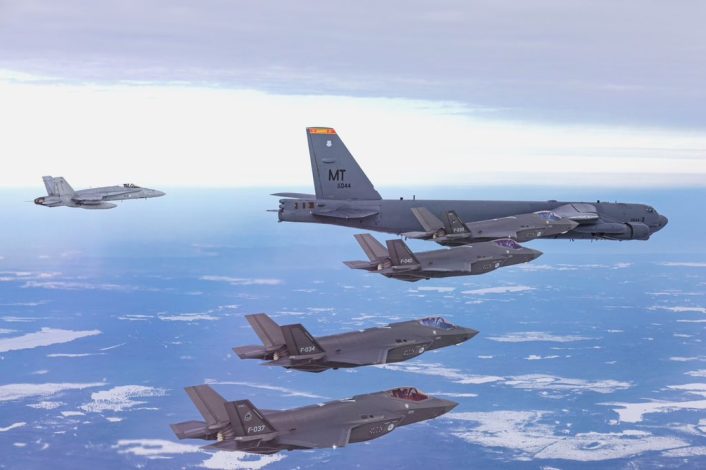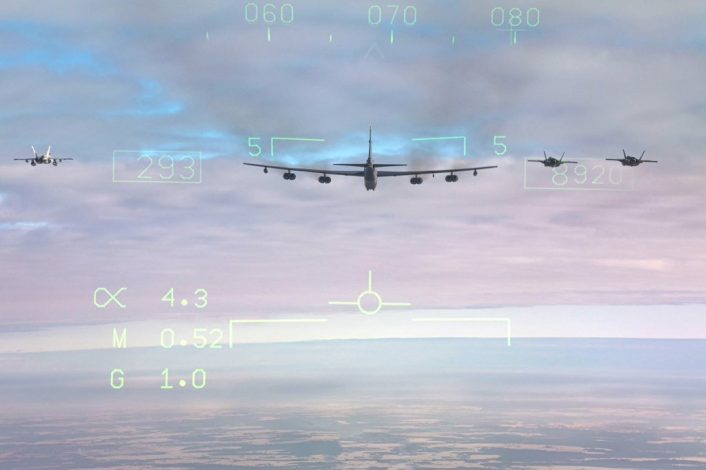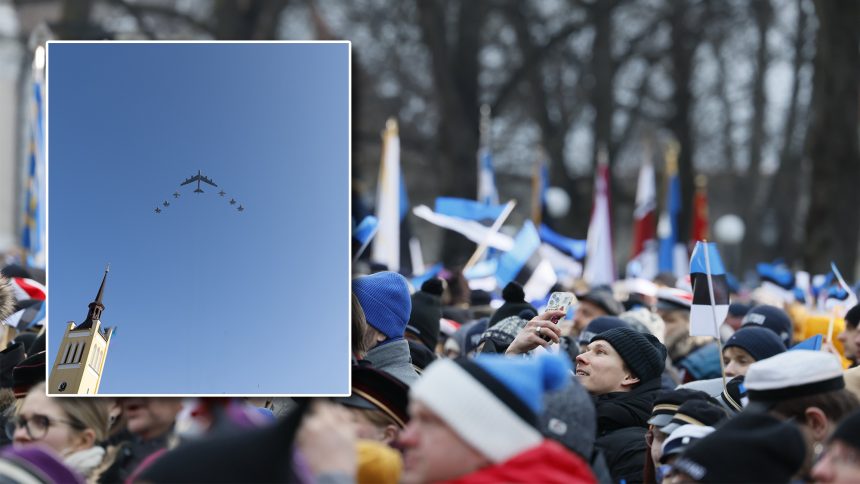The Baltic nation of Estonia celebrated its national Independence Day on Feb. 24, 2025, joined by forces from a number of NATO allies who help reinforce the nation against Russian threats.
Joining the annual military parade in Freedom Square, Tallinn, a mixed formation comprising Finnish F/A-18 Hornets, F-35A Lightning IIs belonging to the Dutch Baltic Air Policing detachment at Ämari Air Base, and a single U.S. Air Force B-52H Stratofortress operating from RAF Fairford, UK.
🙌 Thank you, friends & allies, for celebrating our 🇪🇪Independence Day with us! #Estonia107 #StrongerTogether #WeAreNATO #B52 pic.twitter.com/r3XIQS1eKy
— MoD Estonia (@MoD_Estonia) February 24, 2025
The B-52, callsign MARB 11, departed Fairford at around 0700 UTC heading north east for a routing over Denmark and through the middle of the Baltic Sea. After rendezvousing with the fighter aircraft and performing the flypast, the aircraft left Estonia via Latvia and Lithuania heading south through the Suwałki Gap. The Suwałki Gap is a narrow stretch of border between Poland and Lithuania which separates the nation of Belarus, a key ally of Russia, with the Russian exclave Kaliningrad.
On 24 February, the Finnish Air Force trained together with a 🇺🇸 B-52 Stratofortress bomber and 🇳🇱 F-35s in Estonian airspace. The training session was concluded with a flyover above Tallinn in honour of Estonia’s Independence Day.🇪🇪⁰#ilmavoimat #StrongerTogether #WeAreNATO pic.twitter.com/NGwQOXuE85
— Ilmavoimat (@FinnishAirForce) February 24, 2025
Holding patterns flown by the B-52 east of Tallinn took the aircraft within 40 miles of the Russian border, with the major city of St Petersburg only approximately 110 miles to the northeast. Notably, 60-0044, the airframe used, is one of the U.S. Air Force’s nuclear capable B-52s, marked by distinguishable ‘shark’ antenna fins that can be seen with satellite imagery for treaty verification. Whether this airframe was chosen as part of intentional signaling by the U.S. can only be speculated upon.
Flypasts such as this are routinely worked into exercise planning, and it would likely have been flown as a regular sortie for BTF 25-2. Much like with flyovers for large sporting events in the United States, such as the Super Bowl, the coordination of long distance sorties timed precisely to overfly a location at a specific time is used to practice an important military flying skill. Some missions may require a very specific time-on-target (TOT), and it is imperative that pilots and other personnel are able to ensure these can be met.

Since the Russian invasion of Crimea in 2014, and even more so following the full-scale invasion 2022, NATO forces have been a regular sight at these Independence Day parades. Along with the flypast, ground forces from various NATO states, many of whom are already forward deployed to Estonia and other Baltic nations, took part in the parade through the streets.
Happy Estonian National Day! 🇪🇪
We are delighted to be present at the Independence Day parade on this February 24th. This occasion reminds us of our important place within @NATO alongside our allies.🇫🇷🤜🤛🇬🇧 #weareNato #StrongerTogether pic.twitter.com/xCcQhqtih2
— French Forces in Estonia 🇨🇵🇪🇪 (@FrForcesEstonia) February 24, 2025
Armor on display included K9 Thunder self-propelled howitzers operated by the Estonian Army, alongside Challenger 2 main battle tanks of the British Army. A squadron of Challenger 2s has been located in Estonia for several years as part of NATO’s Enhanced Forward Presence (EFP) mission.
Delighted to be in Tallinn celebrating Estonia’s Independence Day! Big parade, featuring The Royal Tank Regiment from UK pic.twitter.com/QBvIrquYMO
— Mike Southon (@MikeSouthon) February 24, 2025
It was also one of the first outings for Estonia’s new CAESAR self-propelled howitzers. Twelve have been ordered by Estonia from France, with the first six units arriving in January 2025. An option for six additional units is also allowed for by the contract.

The CAESAR features a 155mm gun, capable of firing NATO standard rounds, mounted on a truck chassis (differing from the tracked K9 Thunder). Along with France, the platform is also operated in significant numbers by Saudi Arabia and Ukraine. Orders by Belgium, Denmark, Czechia, and Lithuania will see the mobile artillery guns in service across a variety of NATO nations.
“In Tallinn to attend Estonia’s Independence Day, celebrating the 107th anniversary of the country’s independence.
I am proud to see the CAESAR guns ordered by our partner in June and already delivered, alongside our military personnel, and the French forces of the NATO… pic.twitter.com/aV6TprzqjZ
— French Aid to Ukraine 🇨🇵 🤜🤛 🇺🇦 (@aidefranceukr) February 24, 2025
Visible demonstrations of solidarity with Ukraine were widespread, with the Ukrainian flag displayed prominently alongside the Estonian flag. As one of the countries that make up NATO’s eastern border with Russia, Estonia has been a staunch supporter of Ukraine’s battle. Despite its modest economy and military compared to many NATO allies, Estonia leads the board in terms of the amount contributed to Ukraine as a percentage of gross domestic product (GDP).

As of November 2024, an estimated 34,000 Ukrainian refugees were living in Estonia. Though vastly overshadowed by the numbers taken in by other European nations like Germany, Poland, and the UK, with Estonia’s population of 1.37 million people this means 2% of all people living in the country are Ukrainian refugees. For the UK, for example, the figure is closer to 0.3%. The strong pro-Ukrainian sentiments during Estonia’s Independence Day run even stronger as it falls on the same day as the anniversary of Russia’s full scale invasion.
tallinn preparing for the estonian independence day parade tomorrow 🇪🇪🇺🇦 ukrainian flags everywhere, endless solidarity pic.twitter.com/APfAkLTCCC
— sarah 🚩 (@ratherbeinpisa) February 23, 2025
Estonia has celebrated its independence on Feb. 24 since the Estonian Declaration of Independence was signed on the same day in 1918. As part of the Molotov-Ribbentrop Pact between the Soviet Union and Nazi Germany, Estonia was invaded and occupied by the Soviet Union in 1940 along with Latvia and Estonia. Full independence was not restored until 1991, with the Independence Day parades resuming in 1993 on the original date.









